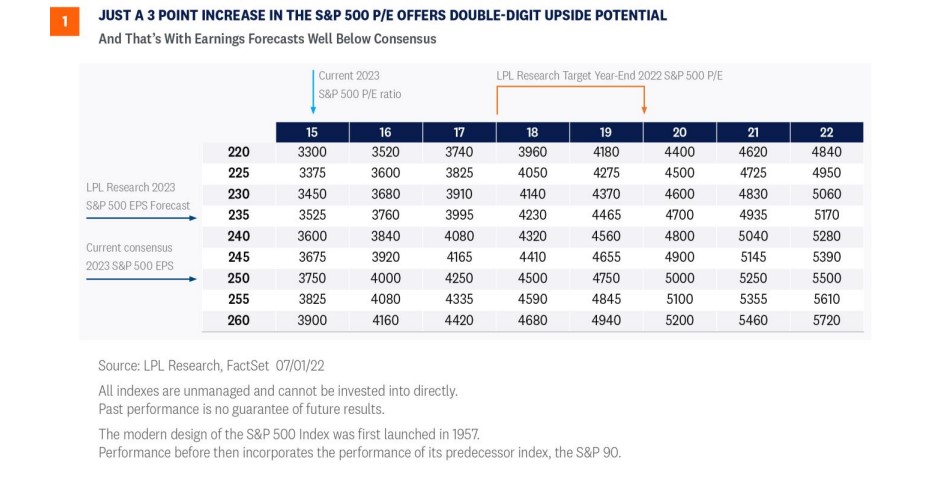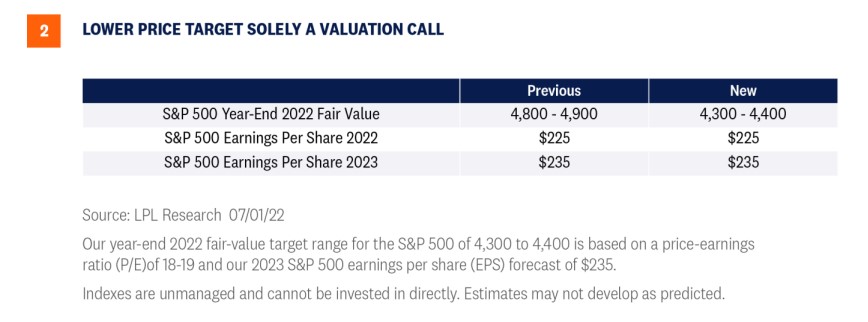
Constructive, Not Complacent: Lowering S&P 500 Target
Stocks have been unable to make up much ground since the June 16 lows, with a bear market rally amounting to only around a 4.3% gain in the S&P 500 Index since then (as of July 1). After the more than 6% rally the week of June 24 and the increasing optimism that came with that bounce, stocks pulled back again last week—the 11th down week for the index in the past 13 weeks. While we acknowledge that a V-shaped recovery is probably not in the cards and prior valuation targets no longer appear achievable, we remain constructive on equities for the second half, but not complacent.
NOT OUT OF THE WOODS BUT SOME ENCOURAGING SIGNS
Clearly markets do not yet believe we’re out of the woods as debates about whether inflation has peaked continue while the Federal Reserve (Fed) stands ready to aggressively hike its target interest rate over the next few months (at least) while shrinking its bloated balance sheet.
But there have been some encouraging signs lately:
- Oil prices are down over 10% since June 8, which will likely translate into lower prices at the pump in the near term.
- The inflation rate implied by Treasury Inflation-Protected Securities (TIPS) over the next five years has fallen from 3.1% to 2.6% over the past month and down from the peak of 3.7% earlier this year.
- The University of Michigan survey of consumers’ long-term inflation expectations fell from 3.3% to 3.1%.
- The latest data on supply chains from the New York Fed indicate supply bottlenecks are easing.
Also, consider the evidence that consumers are in pretty good shape overall heading into the latest inflation surge:
- At 3.8%, the unemployment rate is reaching 50-year lows, while wages are up more than 5% over year-ago levels, according to the latest Bureau of Labor Statistics data. While that worries the Fed, it puts consumers in a better position to weather this storm. Also, consider there are over 11 million job openings in the U.S. compared with 6 million unemployed people. 2 Member FINRA/SIPC
- S. households held $3.2 trillion more in checkable deposits on March 31, 2022 than at the end of 2019 before the pandemic. Money market assets are also nearly $1 trillion above December 2019 levels.
- The financial obligations ratio was 14.2% as of March 31, 2022, below the pre-pandemic lows going back to 1980. Consumers’ discretionary incomes in aggregate are nicely covering debt obligations (mortgages, car loans, home equity loans, etc.).
RISKS ARE CLEAR
Just because consumers have some things going for them doesn’t mean the surge in inflation isn’t painful, nor does it necessarily mean the U.S. economy will avoid recession. LPL Research places 50% odds of a recession within the next 18 months, so we’re not discounting that probability. The Fed’s spotty track record of fighting inflation without causing a recession does little to instill confidence.
The good news is that if the economy does contract to the point where it is officially labeled a recession (the National Bureau of Labor Statistics makes that call), the impact will likely be muted somewhat by the strong financial position enjoyed by consumers heading into it. Keep in mind that two straight negative GDP quarters is not sufficient to “qualify” for a recession. NBER’s broader definition will likely enable the economy to avoid recession in the first half regardless, though GDP may eke out a small gain anyway.
Other risks to keep an eye on include another possible spike in energy prices, which could push interest rates higher and weigh on the economy and stock valuations. Geopolitical tensions could escalate in Europe at any time (though we could also get a surprise resolution/cease-fire). Finally, the longer that inflation remains stubbornly high, the more aggressive the Fed will get with rate hikes, increasing the odds of a recession. Some components of inflation such as housing and wages will be very hard to bring down, and inflation can become entrenched the longer it lingers and potentially gets embedded in consumer expectations.
SO WHAT IS THIS MARKET WORTH?
Valuing stocks during periods of high uncertainty is tricky. On the upside, we think stocks may be worth more than 20 times earnings in a return to an environment of low inflation and low and stable interest rates. We’ll probably get there eventually, but that’s very unlikely to occur this year. Interest rates have only come down because of recession fears, while inflation will still be elevated—even if somewhat lower—when the calendar turns to 2023 (unfortunately).
So a P/E over 20 is probably too rich. Remember stock valuations are inversely correlated to inflation and interest rates.
On the opposite end of the spectrum, we know stocks have traded down to an average of around 13 times earnings during the lows of the past three bear markets. But our belief is that this economic and profit environment is better than in the early 1990s, early 2000s, or 2008- 2009 and therefore supports higher valuations. Add to that our expectation that inflation will soon begin a steady march lower and that late-cycle valuations in the 18-19 range have been commonplace in recent decades. As a result, we believe a price-to-earnings ratio of 18-19 on 2023 S&P 500 earnings estimates is reasonable. As shown in Figure 1, a return to that multiple translates into potential double-digit returns for stocks over the rest of the year assuming earnings come through as we anticipated. On the opposite end of the spectrum, we know stocks have traded down to an average of around 13 times earnings during the lows of the past three bear markets. But our belief is that this economic and profit environment is better than in the early 1990s, early 2000s, or 2008- 2009 and therefore supports higher valuations. Add to that our expectation that inflation will soon begin a steady march lower and that late-cycle valuations in the 18-19 range have been commonplace in recent decades. As a result, we believe a price-to-earnings ratio of 18-19 on 2023 S&P 500 earnings estimates is reasonable. As shown in Figure 1, a return to that multiple translates into potential double-digit returns for stocks over the rest of the year assuming earnings come through as we anticipated.

MAINTAINING EARNINGS ESTIMATES
Solid first quarter results and resilience of estimates during the second quarter set corporate America up to reach, or possibly exceed, our $225 EPS estimate for the S&P 500 in 2022. Our forecast, which is $5 below the consensus estimate of about $230, is calling for an 8% increase this year. Much of that will likely come from the energy sector.
As the second half of 2022 begins, markets will increasingly look to 2023 earnings to assess stock valuations. Our forecast for 2023 S&P 500 EPS remains at $235, just 4% above our 2022 forecast and more than 6% below the consensus estimate of $251.
We believe this earnings outlook is sufficient to support a solid stock market turnaround between now and year-end. Though analysts’ bottom-up estimates haven’t come down materially in recent weeks, calls from strategists that numbers need to come down this earnings season are so widespread that the news may not have to be all that great for stocks to rally on results.
The percent of companies seeing estimates reduced has increased some recently, but the overall market cap weighted numbers have held firm. Results from early reporters with May quarters such as Oracle and FedEx were encouraging.
LOWERING OUR YEAR-END FAIR VALUE S&P 500 TARGET Based on the 18-19 P/E ratio and our $235 per share forecast for S&P 500 earnings in 2023, we believe the S&P 500 year-end fair value is 4,300-4,400, down from our prior forecast of 4,800-4,900.

CONCLUSION
The risk-reward for stocks looks favorable to us at current levels based on what we see as more potential upside than downside. The average non-recessionary bear market decline has been about 24%, roughly in line with the most recent peak-to-trough decline. But for the double-digit percent upside to be realized by year-end, inflation has to start coming down soon, helping boost the economy on the back of consumers.
History appears be on the market’s side, as the S&P 500 could be poised for solid gains ahead:
- After the worst two-quarter performances in history, where the S&P 500 has dropped more than 20%, it has gained back over 21% on average in next half-year, and over 31% on average a full year out.
- The average gain off of midterm election lows, which may have been set in June, has been over 30%.
Despite our still constructive—not complacent—stance, stocks warrant lower valuations based on higher interest rates and troublesome inflation picture. Our revised year-end 2022 fair value S&P 500 target of 4,300-4,400 is still more than 12% above the July 1 closing price at the low end, but is 10% below our prior target. We still expect a growing economy and solid earnings gains in the second half to fuel higher stock prices, though gains will likely be back-end loaded given the time it will take for inflation to come down enough for the Fed to signal a pause.
We continue to recommend an overweight allocation to equities and underweight to fixed income relative to investors’ targets, as appropriate. For more risk-tolerant investors or investors with neutral positioning, we would consider increasing equity allocations slightly, as the LPL Research Strategic and Tactical Asset Allocation Committee (STAAC) has done in July as more evidence that the market’s bottoming process is progressing has emerged.
IMPORTANT DISCLOSURES
This material is for general information only and is not intended to provide specific advice or recommendations for any individual. There is no assurance that the views or strategies discussed are suitable for all investors or will yield positive outcomes. Investing involves risks including possible loss of principal. Any economic forecasts set forth may not develop as predicted and are subject to change.
References to markets, asset classes, and sectors are generally regarding the corresponding market index. Indexes are unmanaged statistical composites and cannot be invested into directly. Index performance is not indicative of the performance of any investment and does not reflect fees, expenses, or sales charges. All performance referenced is historical and is no guarantee of future results.
Any company names noted herein are for educational purposes only and not an indication of trading intent or a solicitation of their products or services. LPL Financial doesn’t provide research on individual equities.
All information is believed to be from reliable sources; however, LPL Financial makes no representation as to its completeness or accuracy.
U.S. Treasuries may be considered “safe haven” investments but do carry some degree of risk including interest rate, credit, and market risk. Bonds are subject to market and interest rate risk if sold prior to maturity. Bond values will decline as interest rates rise and bonds are subject to availability and change in price.
The Standard & Poor’s 500 Index (S&P500) is a capitalization-weighted index of 500 stocks designed to measure performance of the broad domestic economy through changes in the aggregate market value of 500 stocks representing all major industries.
The PE ratio (price-to-earnings ratio) is a measure of the price paid for a share relative to the annual net income or profit earned by the firm per share. It is a financial ratio used for valuation: a higher PE ratio means that investors are paying more for each unit of net income, so the stock is more expensive compared to one with lower PE ratio.
Earnings per share (EPS) is the portion of a company’s profit allocated to each outstanding share of common stock. EPS serves as an indicator of a company’s profitability. Earnings per share is generally considered to be the single most important variable in determining a share’s price. It is also a major component used to calculate the price-to-earnings valuation ratio.
Forward Price to Earnings is a measure of the price-to-earnings ratio (P/E) using forecasted earnings for the P/E calculation. While the earnings used are just an estimate and are not as reliable as current earnings data, there is still benefit in estimated P/E analysis. The forecasted earnings used in the formula can either be for the next 12 months or for the next full-year fiscal period.
All index data from FactSet.
This research material has been prepared by LPL Financial LLC. Securities and advisory services offered through LPL Financial (LPL), a registered investment advisor and broker-dealer (member FINRA/SIPC). Insurance products are offered through LPL or its licensed affiliates. To the extent you are receiving investment advice from a separately registered independent investment advisor that is not an LPL affiliate, please note LPL makes no representation with respect to such entity.
Tracking # 1-05300438 (Exp. 07/23)